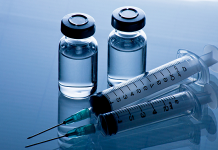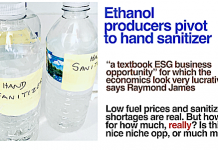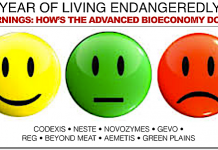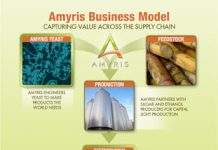Jim Lane
In Canada, BioAmber (BIOA) recorded net income of $4.8M for Q2 2016 and an operating loss of $1.0M on revenues of $2.5M. Revenues were up 73 percent over Q1 and 637 percent compared to Q2 2015.
For those less familiar with the company, it produces succinic acid from sugar at a first commercial-scale plant which opened recently in Sarnia, Ontario. Succinic acid has a small existing global market but can be converted into a variety of chemical building blocks used to produce a range of plastics, paints, textiles, food additives and personal care products.
If for some this relatively small venture is “the hope for the renewable chemicals movement”, the reason lies in oxygen. Which is to say, sugar has it, succinic acid has it, but petroleum doesn’t. That means that any effort to make succinic acid from petroleum involves at least one extra process step the add-back of oxygen. It also means that the yield of succinic acid from sugar is inherently higher, on a percentage basis than, say, the production of hydrocarbons used as diesel or jet fuel, or chemicals such as ethylene.
That lowers the threshold at which renewables can compete on cost with petroleum-based molecules and that’s no small matter when fossil fuel prices have tumbled to 10-year lows. Combine that with the usefulness of succinic acid as a building block, and you have a powerful combination.
So, many eyes beyond the usual collection of employees, investors, and supply chain partners have been on the Succinic Sultans of Sarnia.
The 5 Key Trends
Let’s look at five key BioAmber trends, and measure’s the venture’s progress.
1. Product cost.
Aside from product acceptance already assured via a transformative offtake deal with Vinmar that we covered here, there’s nothing more important than product cost. It’s the fatal problem for most early stage advanced bioeconomy ventures. It’s the difference between being stuck in small, high-margin niche markets, possibly forever and certainly while the cash runs out and a breakout into larger volume markets where the growth lies.
There’s good news here. “The cost per ton of bio-succinic acid sold continued to decrease, with a 30% reduction relative to the previous quarter,” said the Company in its earnings report. In the context of overall goals? “Sarnia variable costs were lowered to the Company’s 2016 target.”
2. Up-time.
If you’ve been following the travails of various cellulosic ethanol ventures, you know that they have excellent product prices at the moment and mandated markets. Production plant up-time has been a huge headache.
On that note, it’s excellent news to read that “Sarnia achieved an uptime rate of over 80% in the month of June 2016, having increased steadily during the second quarter.” The Q3 uptime rates will be critical to understanding if BioAmber has cracked the operational puzzle, but the progress if highly encouraging.
3. In-spec production.
One of the ventures key performance indicators has been the production of in-spec chemicals. It’s fermentation regime has shown a tendency to wobble off course in the early days the result, 37% of the product was off-spec in Q1. Could be that the corner was already turned here. Less than 7% of total Q2 production of bio-succinic acid was off-spec.
4. Cash and inventory on hand.
The miseries imposed by a cash drain need no great emphasis here, for readers who have worked on early-stage ventures in the cash- burn phase. Suffice to say, if there’s one type of burning sensation in the Valley of Death more painful than the others, it’s usually the cash burn. Cash is a little light in BioAmber world but the burn rate is low. There’s $5.5M on hand as of June 30, compared to cash on hand of $6.9M on December 31, 2015. The company added in its quarterly earnings call that it closed on an additional $7.6M from the previously disclosed BDC Capital loan. So, liquidity is assured for now, but a dilutive capital raise may be in the cards before the venture breaks even at Sarnia. We’ll keep an eye on that one.
Another item to note is that the company has 1,200 metric tons of product inventory on hand as of Q2. The plant has a rated capacity of 30,000 tons so, it’s not a big pile-up, but worth watching as both a source of future cash and as a sign that BioAmber’s deliveries are timing well with its production.
5. Overheads.
Project watchers have been keeping an eye on R&D expense, which had ballooned to $5.0M in Q2 2015 as the company readied to launch the new commercial plant. Happily, that’s tumbled to $1.5M.
Interestingly for a company going through a ramp-up, sales expense is dropping. In Q2 2015 the figure hit $1.1M for the quarter, but dropped to $584K in Q2 2016. The company noted that stock option value has dropped as the value of the company’s stock has declined. If the stock begins to rise, that’s go up again. But it’s also a sign that the company’s embrace of a big offtake relationship with selected partners such as Vinmar is going to keep that expense lower than at projects that opt to sell direct to customers.
Reaction from Planet BioAmber
“BioAmber continues to meet ramp-up expectations at its Sarnia plant. We have made excellent progress in the plant’s reliability and performance, while continuing to increase production levels and drive down unit costs,” said BioAmber CEO Jean-Francois Huc. “Second quarter sales were on track, generating a 73% increase in sales over Q1, while Q2 operations improved throughout the quarter, culminating in a June uptime rate of over 80%. The team is now entrenching its operating routines as our Sarnia facility moves towards full production levels,” he added.
The Bottom Line
Progress? Excellent. One more quarter of results is probably all that is needed to assure observers that BioAmber’s start-up period is essentially over. Then, of course, the questions will be the more usual ones of price and production volume. And in the world of renewables, the rate of adoption by customers and the rate of application development.
Which brings us to formulations. We raised this issue with coverage of TerraVia last week. One of the real advantages of succinic acid is that it can be used as a chemical building block. We noted in a review here that “Bio-succinic acid forms the basis for many high-value replacement products, including phthalic anhydride, adipic acid, and maleic anhydride. Fumaric acid is commonly used as a preservative in food and beverages, in the production of paints and coatings, as well as in the production of paper. It is the chemical equivalent of maleic anhydride (MAN) and water, and therefore can be used as a replacement for MAN.”
So, we’ll be keeping a sharp look-out for evidence that formulators are switching from petroleum-based feedstocks to biosuccinic as a source for any or all of those. It will be a huge demand driver, ultimately, not only for BioAmber but for Reverdia, the joint venture between DSM and Roquette Frères, which in 2012 commenced operations in Cassano Spinola, Italy, at a 10K/yr biosuccinic acid plant. And somewhere out there is the mysterious Myriant venture, which opened its plant in Louisiana and drew a thick iron curtain around the project’s progress.
Jim Lane is editor and publisher of Biofuels Digest where this article was originally published. Biofuels Digest is the most widely read Biofuels daily read by 14,000+ organizations. Subscribe here.








